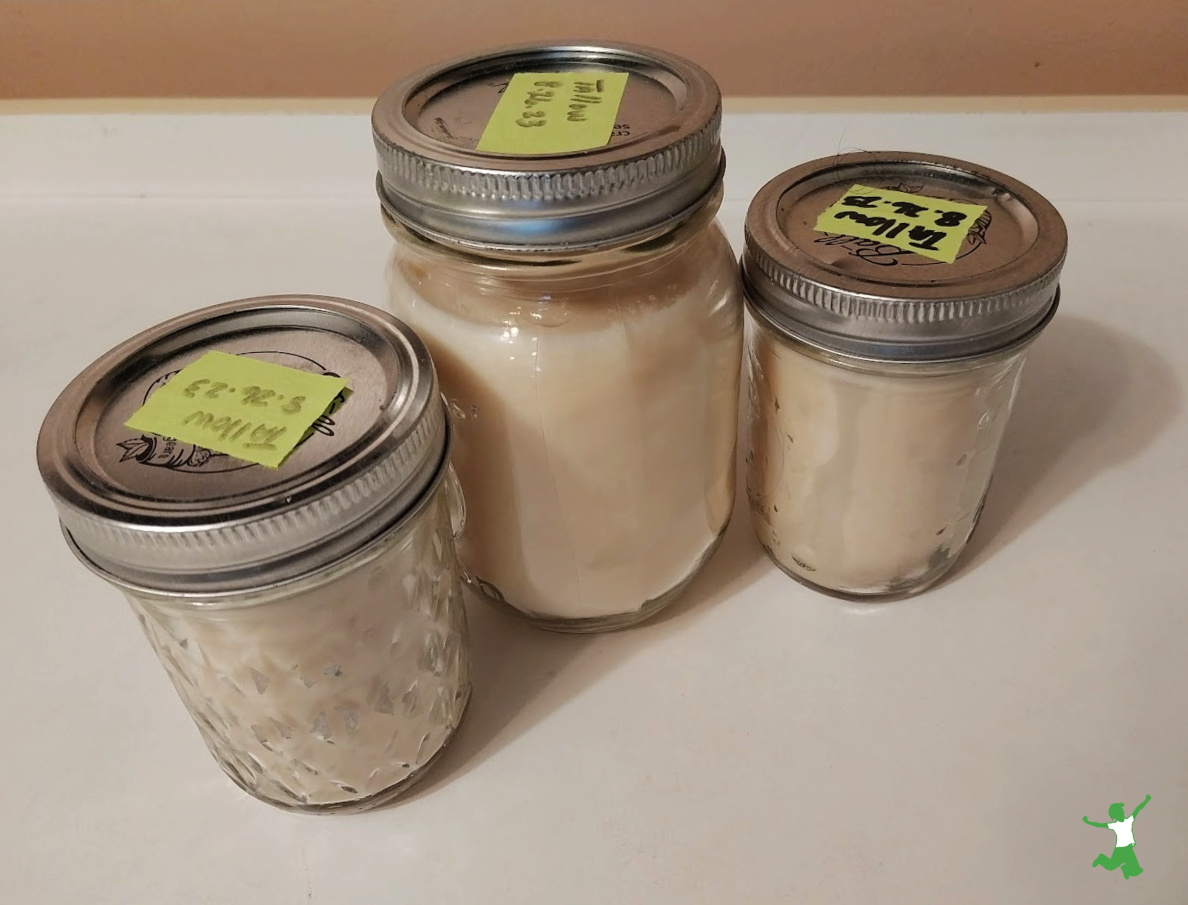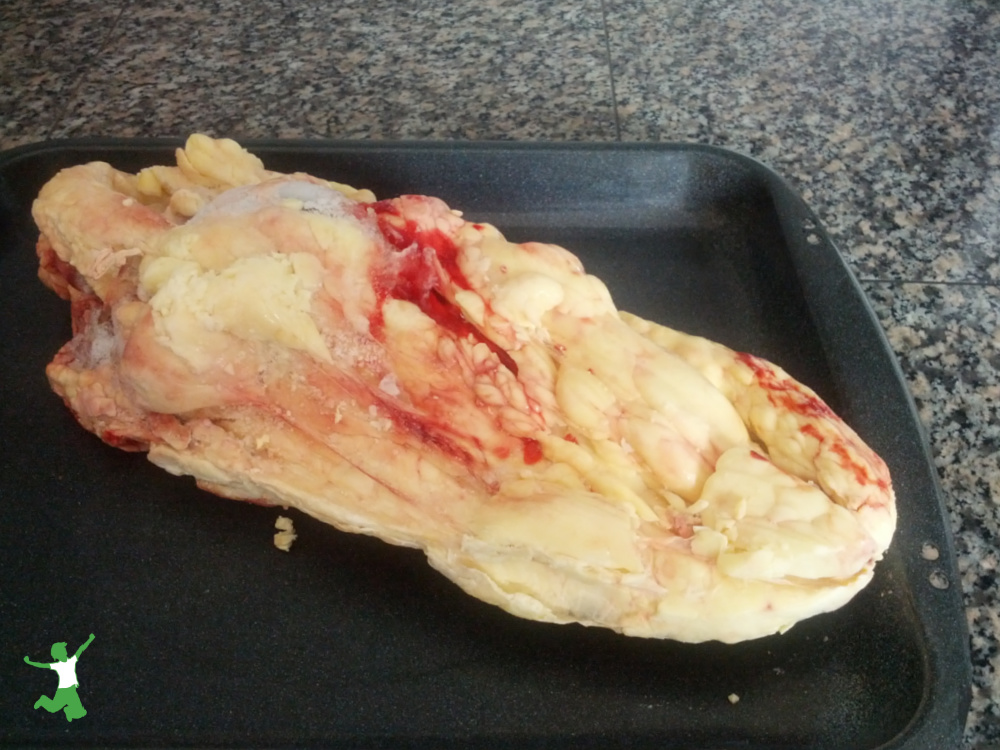How to render tallow from an intact piece of beef suet from your grassfed farmer. This traditional recipe with video how-to makes several jars of tasty pastured beef tallow to last you many months or even a year!

Tallow is hands down my favorite traditional fat to use for frying. I like it even more than lard. It is ideal for this purpose as it has less than 3% polyunsaturated fats. This amount is just a bit less than coconut oil.
What’s more, if your tallow comes from cattle finished on grass or given grain for a very short period of time (a few weeks at the most) before processing, a good share of those polyunsaturates are in the form of conjugated linoleic acid (CLA).
This fatty acid helps build muscle, assists with weight loss, and drastically reduces cancerous tumor risk.
These are just a few of the many health benefits.
Beef Tallow: Not Just Any Fat
Tallow is a very special type of beef fat.
It is the rendered form of suet, which is the nutrient-rich beef or mutton fat found around the organs, particularly the kidneys.
It is the highly prized nourishing fat used in pemmican, a traditional food used by Native Americans to survive harsh winters. Sometimes they subsisted on nothing else for weeks on end with no loss in health!
Traditional pemmican includes tallow in a 1:1 ratio with dried and powdered, ideally, grass-fed muscle meat. It is the ultimate survival food.
Besides CLA, another notable fat present in high amounts in beef tallow is palmitoleic acid, which is highly anti-viral and anti-bacterial.
Fatty Acid Profile
The fatty acid profile of beef tallow is approximately 55% saturated fats and 40% monounsaturated fats.
Both of these fatty acids are very heat stable and do not easily produce free radicals when heated, unlike toxic liquid seed oils.
The smokepoint for tallow is at least 350°F (177°C). Some sources put it as high as 400 °F (204°C), making it an excellent choice for frying.
Preparation and Storage
Rendering pastured tallow is a simple process. It is very similar to the method for rendering pork lard.
From start to finish, the how-to video demonstration in the recipe below shows you exactly what you need to know to produce several jars full that will last you a very long time!
My favorite dishes for using homemade tallow are stovetop french fries, roasted vegetables, hush puppies and shelf-stable pemmican (for the emergency pantry).
Note that pastured tallow is a beautiful yellow color when liquid immediately after you render it. The color lightens to beige at room temperature and in the refrigerator. It whitens a bit further in the freezer.
If you live in a cool climate, tallow keeps well in the pantry.
I choose to refrigerate as this is my preference in hot, humid Florida.
In my experience, rendered beef tallow will keep many months in the refrigerator and years if you freeze some!
Tip: Dehydrate the leftover kidney and organ tissue in the oven and then pulse in the food processor to make pastured organ meat powder. Blend 1-2 tablespoons of the powder into soups and sauces for extra flavor! Store the powder in a mason jar in the refrigerator.
Alternatively, mix the leftover kidney and organ tissue from rendering the tallow with homemade dog food.
Where to Find Beef Suet to Make Tallow
Before you can make your own tallow, you first need to source an intact piece (or coarsely chopped pieces) of beef suet from a pastured farmer.
Below is a picture of what a full piece of beef suet looks like (sitting on my counter, ready to be rendered!).

The absolute best way to source suet is to “split a cow”, otherwise known as buying beef shares directly from a grassfed beef farmer. The linked article provides the details on where/how to do this if you are a newbie to the process of buying farm-direct products.

How to Render Tallow
The traditional method for rendering tallow from an intact piece of suet that you can obtain from a pastured farmer.
Ingredients
- 1 intact piece of suet preferably grassfed
Instructions
-
Take an intact piece of suet and cut into medium to small pieces on a large cutting board. Remove the kidney and set aside.

-
Place the suet pieces in a large pan.

-
Place pan in an oven preheated to 175-200 °F/ 79-93 °C
-
Every hour or so, remove the pan and pour off the melted tallow. Sieve through a cheesecloth to remove any tissue.

-
Continue the process until all the fat has rendered. This will take a few hours. Tallow is quite yellow when it is liquid.
-
Pour strained tallow into glass mason jars after it has cooled. Screw on the lids and refrigerate. As it hardens in the fridge, tallow turns a whitish beige color. Tallow will keep for many months in the refrigerator and a year or more in the freezer.
Recipe Video









How timely, I just got about five pounds of beef far from my share of a cow.
I know you mentioned suet in the video but can you explain the difference b/w suet and tallow? I have suet from a cow in my freezer and wondered if I can use the same process in your video to render it??
I just rendered some lard last night! 🙂
When I make bone broth from beef bones I get this fat layer on top after putting it in the refrigerator.
Can I use this fat for cooking?
What’s the name of this fat then?
Will pick some up on the next farmers market trip! Great article by the way on oxalates and candida. No clue it worsened the problem.
I’ve been rendering beef tallow for a few months now, but I do it on the stove! It’s the most economical healthy fat when you do it yourself! For me it comes out to about 3¢ an ounce.
Thank you!
I’m wondering if fat from Bison would be okay to use. Most of the local beef producers around me say there isn’t enough fat on the cows to sell for tallow. But I can get Bison fat from animals raised in the mountains on grass. Thoughts?
Megan, I think bison fat is absolutely wonderful, and great for cooking!
Great! Thank you for posting. Hopefully many of those traditional fats will come back in people’s kitchens.
yummy!